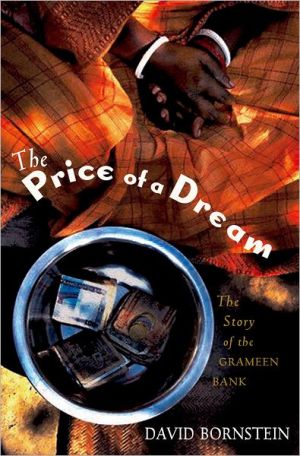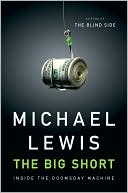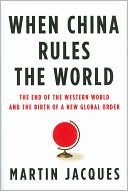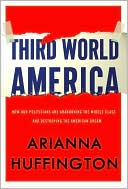The Price of a Dream: The Story of the Grameen Bank
This book is the compelling story of the Grameen Bank, one of the most successful development organizations in the world. Founded by Muhammad Yunus in Bangladesh in 1976, the Grameen Bank has extended small loans for self-employment to more than two million women villagers and has helped lift hundreds of thousands out of poverty. The Grameen Bank's "trickle up" approach has inspired the creation of hundreds of "micro-credit" programs around the world and helped to reshape international...
Search in google:
The Price of a Dream tells the remarkable story of the Grameen Bank, the groundbreaking "village bank" that has revolutionized the way people around the world fight poverty. The Bank's model—providing collateral-free "micro-loans" for self-employment to millions of women villagers in Bangladesh—has inspired and shaped the thinking of economists, policy makers, business people, development workers and a generation of social entrepreneurs. Both liberal and conservative policy circles have championed the Bank's ability to transform the lives of its clients and help them escape the vicious cycle of deep economic hardship.Drawing upon interviews with villagers, development workers, economists, and the Bank's founder Muhammad Yunus—a recipient of numerous humanitarian awards—the book shows how the Grameen Bank grew from an experiment in one village to an organization that lends billions of dollars in small individual loans. Publishers Weekly Described by its founder, Muhammad Yunus, as a "socially conscious capitalist enterprise," the much-lauded Grameen Bank in Bangladesh seems to be one of the Third World's brightest success stories. By viewing poor people as potential entrepreneurs, the bank has helped village people, especially women, to better their lives in small but significant ways. Bornstein, a Canadian journalist based in New York City, provides an episodic, sometimes choppy portrait of Grameen, Yunus and some of the people whose lives have been affected by the bank. Bornstein's portrait isn't all rosy, however. He hedgingly describes conflicting opinions on whether the bank, which receives significant amounts of grants and low-cost loans, could survive on its own. And, since many American organizations have been studying Grameen, he awkwardly assays the burgeoning "microcredit" movement that aims to provide loans to the poor here. The lesson of Grameen, he concludes, is not extrapolation from abroad but the importance of seeking new solutions to and institutions for complex social problems. (May)
Prologue: This Business of Bangles Introduction Part I - The Idea 1. Fairy Tales 2. 856 Takas 3. Social Collateral 4. It Cannot Be Done 5. He Found You Under a Tree? 6. If You Want to Convince Us Part II - The Villagers 7. Water Upon Land 8. It's All on Trust 9. Stirring the Money 10. Sabina Yasmin 11. The Center Meeting 12. It's Their Problem 13. Can You Walk Far? 14. A Petticoat Part III - The Organization 15. We Don't Want Windows 16. Independence 17. A New Culture 18. A Natural and Better Fighter 19. If a Big Dam Breaks 20. This Is Her Factory 21. A Conversation 22. Peace of Mind 23. It Was Like a Fish Market 24. Little Checks and Big Checks Part IV - The System 25. Laying the Foundation 26. I'm Not a Woman Anymore 27. The Logic of Grameen 28. Begum Rokeya 29. The Death of Ali Haider 30. Don't Think of These Things? 31. The Wisdom in Smallness 32. Armed with Information Part V - The World33. Credit as a Human Right 34. How Can You Go On with a Situation Like This? 35. An Expensive Way to Transfer Technology 36. A Risk Taker 37. A Great Strategizer 38. An Intensive Care Unit 39. Two Cyclones 40. If I Had to Become a Businesswoman 41. Oirashi's Final House Part VI - The Future 42. The Golden Boat 43. One Thousand Doctors 44. The Luck of Manijira 45. An Infinite Amount of Work 46. She Turned Her Face to the Light 47. Struck by Lightning 48. The Price of the American Dream 49. Sociall Conscious Capitalism 50.Everywhere You Look Interest Acknowledgments Author's Note Afterword Index
\ Publishers Weekly - Publisher's Weekly\ Described by its founder, Muhammad Yunus, as a "socially conscious capitalist enterprise," the much-lauded Grameen Bank in Bangladesh seems to be one of the Third World's brightest success stories. By viewing poor people as potential entrepreneurs, the bank has helped village people, especially women, to better their lives in small but significant ways. Bornstein, a Canadian journalist based in New York City, provides an episodic, sometimes choppy portrait of Grameen, Yunus and some of the people whose lives have been affected by the bank. Bornstein's portrait isn't all rosy, however. He hedgingly describes conflicting opinions on whether the bank, which receives significant amounts of grants and low-cost loans, could survive on its own. And, since many American organizations have been studying Grameen, he awkwardly assays the burgeoning "microcredit" movement that aims to provide loans to the poor here. The lesson of Grameen, he concludes, is not extrapolation from abroad but the importance of seeking new solutions to and institutions for complex social problems. (May)\ \ \ \ \ Library JournalThe Grameen Bank, located in Bangladesh, is an experimental financial institution born out of the vision of one man over two decades ago. Mohammad Yunus, the founder, felt that if a bank could be designed to serve the poorest people-often landless villagers-they could be trusted to manage their own money and solve their own problems. More important, Yunus felt they could become self-sufficient and break the cycle of poverty. Bornstein, a Canadian journalist, interviewed many bank employees (including Yunus) and Bangladesh villagers whose lives were changed as a result of their involvement with Grameen. "This is about people managing themselves, solving their own problems, creating their own jobs," one bank official comments. Bornstein's tale is memorable and often inspirational, and he tells it exceedingly well. Highly recommended for public libraries.-Richard S. Drezen, Washington Post News Research Ctr., Washington, D.C.\ \ \ Kirkus ReviewsA welcome and readable account of the effort of a unique bank in Bangladesh to help that country's poor.\ Bangladeshi native Muhammad Yunus came to America to study economics and returned home to aid his countrymen. So poor that it is often called "The Fifth World," Bangladesh has high poverty and birth rates and is frequently devastated by monsoons. Its thousands of villages are poor, but Yunus saw that many of the residents had real skills and came to believe that if they were provided with the means to borrow money they could find ways to support themselves. In 1975, he began what became the Grameen Bank (gram is the Bangla word for village) and distributed small loans—some for as little as five dollars—to the poorest. Most of the loan takers were women. In return, he demanded precise, weekly repayment of the loans and insisted that villagers join together in small groups so that if a member fell behind, the others would encourage her to pay her loan. Yunus kept Grameen bound to its ideals, and today the bank thrives, lending at a fair interest rate while still turning a profit. It has made loans in excess of billion and has over one thousand branch offices. The employees of Grameen have an absolute dedication to the bank, and the bank has had an enormous effect on Bangladesh. Bornstein, a journalist, does an excellent job of tracing the growth of the bank in relationship to the country's recent history. He also cogently explains why large public works projects in developing countries are frequently disasters. Yunus's view, one that he teaches to other countries as well, is that the populace of a developing nation must learn to take care of itself.\ A genuinely amazing story and an interesting read in an age when aid to the poor is demonized.\ \ \








